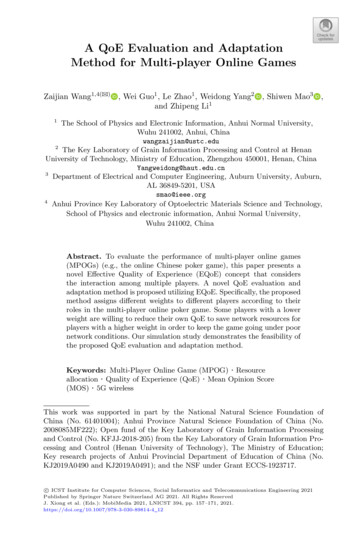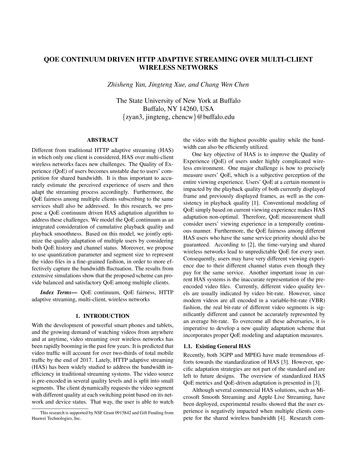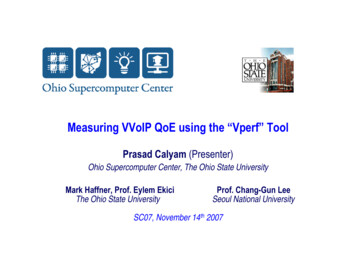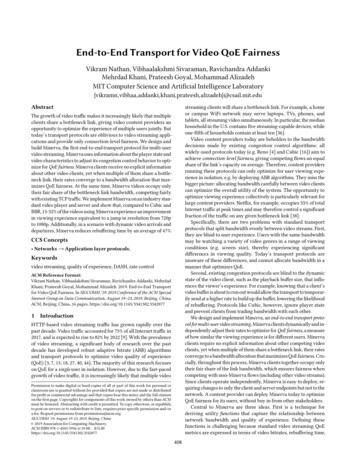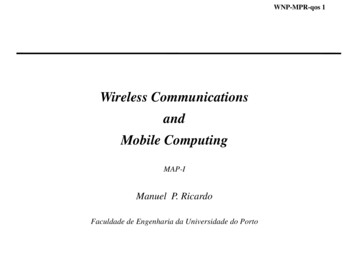
Transcription
QoS and QoEMagda El ZarkiProfessor of CSUC IrvineEmail: elzarki@uci.eduhttp://www.ics.uci.edu/ magda
Network Impairments: Packet Loss,Delay and Jitter Network Measurements: Performance Parameters - e.g., average end to end delay,maximum jitter, % packet loss Service Guarantees – Quality of Service (QoS) that can beexpected for a particular application. Service Contracts – Ensure that e.g., 10% of time the QoS ismet on all traffic flows of an application or servicetraversing a network How to capture their impact on end users andapplications? Quality of Experience User experience Impact on game playability
QoS vs QoE QoS – Quality of Service: network characteristics/behavior Performance guarantees given by network provider basedon measurements QoE – Quality of Experience: impact of network behavior on end user some imperfections may go unnoticed some imperfections may render application useless not captured by network measurements a 5% packet loss could be invisible if it affects background a missed target due to a 100ms delay can affect game outcome
Online GamesGamePlayer /ClientClient /ServerPlayer/Player
Latency CompensationDescription, Causes and Corrections
Outline IntroductionNeed for Latency CompensationTechniquesoPredictionoTime ManipulationoVisual TricksLatency Compensation and Cheating
Client Server Architecture There is a single dedicated server which performs allthe intelligent functions and controls all operations.All other client machines connected to the server aredumb clients which only provide visual aid to theusers and collects user input.All user requests (inputs) are sent from the dumbclient to the server which carries out the request andsends the result back to the client.
Latency in Network Games Most games today run on the client serverarchitecture with a single server which handles thegame logic and every request made by a player inthe game is processed at the server.Thus, when a request is made by a player, it travelsfrom the client to the server and back to client, andthis transmission introduces possible latency in thegame.
Schematic View of Latency
What is Latency Compensation? Latency Compensation is the method of minimizingand hiding latency of the network through varioustechniques, so that the system appears veryresponsive and impressive.
Need for Latency Compensation:Example 1Illustration of the effects of latency on running (Madden NFL2003).2.1.User is pressing left and the player moves left.2.User is pressing up, but player continues left because oflatency.3.Running back goes out of bounds!3.1.
Need for Latency Compensation:Example 21. Illustration of the effects of latency onrunning (Madden NFL 2003).1. User is pressing throw, but throw is notprocessed yet because of latency.2. Throw starts processing here because oflatency3. Defender intercepts throw!2.3.
Techniques for Latency Compensation There are various methods that can be applied tocompensate for latency or mute its effect: Prediction- Time Manipulation- PlayerOpponentTime DelayTime WarpData CompressionVisual Tricks
Predictiono Two classes:o Player prediction: The game client responds tothe user immediately without any delay (i.e.waiting for server to acknowledge action) - thelocal system renders the client’s actionsimmediatelyo Opponent prediction: The client predicts thebehaviours of the opponent before the serveractually sends them to the client
Player Prediction The client takes input from the user (player)The client predicts the server response only for theplayer's actionsThe player’s actions are not subjected to the roundtrip delay (to the server and back), thus removingany network latencyThe game appears very responsive - like a nonnetworked game
Prediction Algorithm Sample user inputPack up data and send to serverDetermine visible objects and game stateRender scene based on local actionsReceive updates from server and unpackCorrect for any discrepanciesRepeat.
Drawbacks: If there is a discrepancy between the actual server game responseand the client side prediction, the client needs to make theadjustment in the game stateThese adjustments could be abrupt and could cause jitter anddeteriorate the consistency of the game. A client could useInterpolation, between the rendered local world and the serverupdate showing the position of units at a later time. But instead ofimmediately rendering the latest update the client interpolates theworld at intermediate states, allowing the local world state toprogress smoothly to the server world state.There is a constant trade-off between game responsiveness andgame consistency
DrawbacksResponsiveness and consistency have a constanttradeoff.
Opponent Prediction In this technique the location and movement of anopponent's unit is predicted by the clientIt starts on the basis of the unit's last knownposition, and computes the current predictedposition based on the unit's speed and direction ofmovement.The predicted position of the opponent's unit isused until the opponent sends an update for thenew position within a predetermined threshold/errorlimit.
Opponent Prediction Cont'd The update is sent when the unit owner determinesthat the other players are not able to accuratelypredict the position within the predeterminedthresholdThe update sent by the unit owner contains thecorrect position, velocity and orientation of the unitPredetermined threshold refers to the acceptablerange within the original position of the opponent,where the opponent's unit can be placed forassuming correct prediction.
Opponent Prediction Cont'd
Opponent Prediction Cont'd The picture shows the view by the owner of the unit.The solid line in the middle shows the actual path as theplayer controlling the unit would see it.The two thinner, dashed lines that run parallel to themiddle line represent the threshold for the opponentpredictions.The thicker dashed lines represent the unit owner’srecord of the opponent’s prediction.If the unit owner’s predicted location of the airplanegoes outside this threshold, the unit owner sends amessage to all opponents with an update on the newposition and direction.
Opponent Prediction Cont'd The initial position and direction is sent at time t0, andsubsequent updates are sent at t1, t2, and t3.The bottom picture depicts the view that the opponentswould see.The opponent uses the last known position anddirection to predict the unit location until an update isreceived, whereupon the new position and direction areused.
Trade-offs Itlocationrequires that each client run an algorithm to extrapolate theof each unit for each frame rendered Smallervalues for the update threshold can provide more fidelity inopponent's prediction at the cost of requiring more frequent updates. This requires higher bandwidth and processing overhead.On the other hand, larger values of the update threshold providedecreased fidelity but requires a lower update rate, therefore lessbandwidth and lower processing overhead.This tradeoff depends on the game, the network and the clientprocessor and the players’ preference.Fairness – players further away get updates to locations later thanothers and so are at a disadvantage with seeing a wrong “gameview”. Solution: send clients further away more location updates.Errors can result in game disruptions. Some games use a gamecontrolled avatar to adjust position of the object, e.g., position of asoccer ball – computer controlled player can be used to adjustposition.
The Prediction Algorithm Two main algorithms commonly used in locationbased prediction are: The first algorithm predicts on the basis of the unit's lastlocation and its velocity at that time The second predicts on the basis of the unit's last knownposition, its velocity and acceleration at that time.More sophisticated algorithms make use of the roll,pitch, direction and may also do predictions ondifferent parts of the unit independently.
Prediction Cont'd Assuming x(t) is the position at time t and the lastupdate for a unit’s position was received at time t0. Withno opponent prediction, a client will assume the locationof a unit at time t1 to be the same as the location of theunit at time t0 .x(t1) x(t0)Now assuming a constant velocity (v), a simpleprediction algorithm would predict the location of theunit to be:x(t1) x(t0) v (t1 t0)
Prediction Cont'd Adding information about a constant acceleration (a), thelocation of the unit would be predicted to be:x(t1 ) x(t0 ) v (t1 t0 ) (1/2)a (t1 t0 )2 In general, units with high inertia are easier to predict(like a rolling stone) than units with lower inertia (aperson walking).
Time Manipulation The game states rendered at the clients are different becausea server response takes some time to reach the client machinedepending on the location of the client from the server.Thus, when the same response reaches players at differentpositions in time, there is an unfairness factor introduced in thegame.Two efficient techniques for handling this manipulation areTime Delay and Time Warp.
Time Delay In this technique there is a delay in processing andsending of user commands to equalize latency.Instead of processing and responding to the clientrequest right away, the server purposely introduces adelay, thus allowing a remote client to respond to thegame state.This technique ensures that all clients have the sameeffective latency in the game world at the server –consistent game view
Time Delay Cont'd The world state updates sent by the server can also be delayed inbeing sent out, sending the response to a client that is far awaybefore sending the response to a client that is closer.The clients themselves can introduce buffering to equalize latency,with the client that is closer to the server delaying the processing ofthe server response while the one which is further away canprocess the response immediately.But while buffering works towards equalizing the latency amongvarious clients, it makes the game play less responsive.
Time Warp Another mechanism for time manipulation is to have a serverrollback or Time Warp the events in a game to the point when aclient command was input.For example: the player shoots at an opponent at time t0, but by thetime the message arrives at the server at time t2 , the opponentmoved at time t1. The server uses the time warp technique and rollsback the events it had processed since the client provided the input.In this case, the server might determine that this older event has abearing on subsequent events, changing their effect to make theglobal world state consistent. In other words, the server maydetermine that the player hit and killed the opponent, meaning thatthe opponent’s movement at time t1 was invalid.
Time Warp General Algorithm for the Server: Receive packet from client Extract information (user input) Elapsed time current time – latency to client Rollback all events in reverse order to current time –elapsed time Execute user command Repeat all events in order, updating any clients thatare affected Repeat.
Time Warp Cont’d For Time Warp it is critical to have an accuratemeasurement of the latency between a client and aserver so that the game time can be rolled back theexact amount of time.The popular first person shooter game, Half-Life 2 (HL2),makes use of time warp. For testing purposes, the HL2server allows additional lag to be added to the clients.The server administrator can observe the actual locationof a unit and the location for the unit with time warp byhaving a separate client on the same machine as theserver (a listen server).
Time Warp Cont’d Figure shows a screenshot of an HL2listen server.Round-trip latency to the client - 200 ms,meaning the user’s commands areexecuted 100 ms before the screenshot.Grey boxes show the target position onthe client where it was 100 ms ago.Since then, the target moved to the leftwhile the user’s command was travellingover the network to the server.When the user command arrives at theserver, the server rolls back time (timewarp) to put the target in the position itwas at the time the user shot, indicatedby the black boxes. The serverdetermines there was a hit (the clientsees blood from the wounds).
Time Warp Shortcomings Can cause inconsistencies Example: Suppose a player places the cross-hairs of a gun on anopponent and fires. The server, using time warp, will ultimatelydetermine this is a “hit”. However, in the meantime, because of client–server latency, the opponent may have moved, perhaps even arounda corner and out of sight. When the server warps time back to whenthe shot was fired and determines the opponent was shot, it will seemto the opponent that the bullets actually went around the corner.
Data Compression It is evident that reducing the size of the message sentbetween a server and a client can also reduce latency.A smaller packet has shorter transmission time than alarger packet.Types of compression: Lossless CompressionOpponent Prediction Delta Compression Interest ManagementPeer to Peer Update Aggregation
Visual Tricks These are some additional techniques which do not involve networking, butare used to cover up network latency on the client side.A start-up animation could be used to hide latency from the client to theserver. Example: When a boat is ready to move, the game may require it to raisesails before it starts to actually move. Such animations delays can take acouple of hundred milliseconds, allowing the message to go to the serverand back before the unit actually moves. Thus, if a server indicates the move is not allowed due to any reason,there is no discrepancy to fix, and the player feels that the game is veryresponsive.Local confirmation of an action having taken place can be used immediatelyeven if the remote effect is not confirmed by the server. Example: If a player puts his finger on the gun, the game client can playa shooting sound effect and show a smoke puff, even though the effectof the shot is not determined for some time.
Latency Compensation and Cheating The anonymity factor in online games means there aremany opportunities for cheating.Some of the latency compensation techniques whilereducing the effect of latency introduce moreopportunities for cheating.
Latency Compensation and Cheating (Cont.) Cheating Opportunities Examples: With time warp, a client could interfere with measurements about round-trip time,making the server believe the client is further away than it actually is. This wouldallow the client to respond to events that, in essence, happened in the past andhence giving unfair advantage. With time delay, a client with slow reflexes could claim a higher latency than itactually has, causing a large time delay at the server, thus neutralizing the betterreflexes that opponents may have. Interest management, while reducing network bitrates, can also be abused bycheaters. Clients can claim interest in game state that they could otherwise notsee, using this information to gain a tactical advantage.Server Control: This justifies the need of an authoritative server which could confirm or refuteinappropriate client requests and actions and also keep track of the exact timedelay between the server and each client.
QoE - Quality of Experience: impact of network behavior on end user some imperfections may go unnoticed some imperfections may render application useless not captured by network measurements a 5% packet loss could be invisible if it affects background a missed target due to a 100ms delay can affect game outcome .


